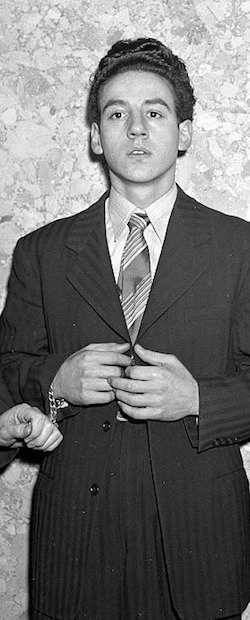Zoot Suit Killers
Joseph Annunziata,
On November 20 1942, a Brooklyn jury returned guilty verdicts on a pair of Williamsburg teens, 16-year-old Neil Simonelli and 18-year-old Joseph Annunziata, for the murder of Irwin Goodman, their math teacher at William J. Gaynor High School. The two of them had never much liked Goodman, a 36-year-old father of two. When he reported them to the principal for smoking in the boys’ room, they walked eight blocks to Simonelli’s home, where they picked up a pistol, then back to the school. They confronted Goodman and got into a scuffle with him. The gun, which Annunziata was holding, went off, perhaps accidentally, fatally shooting Goodman through the back. Because the jury entertained a doubt that the shooting was premeditated, they convicted the boys of murder in the second degree. The pair went off to Sing Sing together to begin sentences of 20 years to life. Had the verdict been first-degree murder, they could have been the youngest New Yorkers ever executed.
The city’s newspapers, from the New York Times to the Brooklyn Eagle, provided extensive coverage of the case, and there was commentary in national magazines like Time. What fascinated them all, beyond the crime itself, was the boys’ lifestyle and attire: uniformly, the press described Simonelli and Annunciate as “jitterbugs,” “Zoot Suit Youths” and “Zoot Suit Killers.”
Neil Simonelli
Whether or not anyone in the press had actually seen Simonelli and Annunziata wearing zoot suits was a moot point. By 1942, “zoot suit” was a metonym for “juvenile delinquent.” What the black leather jacket and the hoodie were to later generations, the zoot suit was to the war years.
When the zoot suit first appeared it was mostly associated with black youths and the jitterbug in neighborhoods like Harlem. It consisted of an outrageously outsized jacket, with superwide padded shoulders, that hung down to the knees and the fingertips. The pants were exaggerated as well, ballooning and deeply pleated, then pegged tight at the ankles. A broad-brimmed or porkpie hat, pointed or platform shoes, a long watch chain, and a variety of tie styles completed the ensemble.
At first it was seen as a rather comical and harmless style, just another example of young people going to silly sartorial extremes. It began to look more sinister amid increasing worries about what life in wartime was doing to America’s families and children.
The Depression and Dust Bowl 1930s had already wreaked havoc on the American family, turning millions into homeless migrants, splitting off husbands who went on the bum seeking any work they could find, forcing some mothers and daughters into prostitution, and enticing some young men into lives of crime and gangsterism. The war brought new dislocations and disorder. Some 15 million Americans were uprooted again, trekking across the country seeking defense work. Many moved more than once during the war, and few returned to their point of origin after it.
From 1940 well into 1943, the Selective Service exempted fathers with dependent children. But with the military’s ever-expanding need for manpower, fathers eventually began to be drafted. The government started sending monthly checks to servicemen’s families in 1942, but in expensive cities like New York it often wasn’t enough to run a household. By 1944, more than a million servicemen’s wives had taken jobs.
Kids were working too. In the Depression years, new legislation against child labor had been enacted, largely to prevent kids from taking scarce jobs away from adult males. Now, as labor shortages grew more severe, many states and localities rolled back those restrictions. As a result, by 1944 high school enrollment had fallen 25%, while the employment of youths 14 to 18 had more than doubled. An estimated 2 million high schoolers had dropped out to take jobs, and many planned not to go back to school.
The impact of all this on kids’ lives could be profound. They might lose their father for the duration, or forever. They might follow their parents from one defense job to another, always the new kids in the neighborhood and at school. If they stayed in school, whether dad was gone and mom worked or both parents worked, kids now found themselves with lots of free, unsupervised time. If they dropped out and took jobs, they had cash in their pockets to spend any way they wanted.
And they were growing up in wartime. Teenage boys too young to be sent to fight knew that in a year or two or three they might well be. In the meantime they wanted to look and feel as manly as their fathers and older brothers in uniform. According to law enforcement, teenage gang activity and street fighting escalated, and the violence grew more serious; where teen gangs had formerly used fists and clubs, they now wielded zip guns and flick-knives, sometimes inflicting deadly harm. Teenage girls as well as boys took to drinking, smoking, and sexual pickups, in full eat-drink-and-be-merry mode. Adults labeled it “war degeneracy.” It’s no coincidence that the terms “youth culture” and “teenager” (or “teen-ager”) were also coined in this period. They were something new, a generation of latchkey kids, army brats, war orphans.
The story of Simonelli and Annunziata neatly encapsulated what was seen as a broader trend. Youth crime figures in the first full year of the war were so disturbing, J. Edgar Hoover said, that a “counter-offensive” was necessary to prevent “a breakdown on our home front.” He told a graduating class at the FBI Academy, “Something has happened to our moral fibers when the nation’s youths under voting age accounted for 15 per cent of all murders, 35 per cent of all robberies, 58 per cent of all car thefts and 50 per cent of all burglaries.” Later studies showed that nationwide juvenile delinquency arrests rose 72 per cent during the war. In Brooklyn, it was 100 per cent.
By 1942, the year of Simonelli and Annunziata, the zoot was identified as much with this behavior as with lindy-hopping and jitterbugging. That year, the War Production Board actually declared the zoot suit unpatriotic, because it was a waste of material in a time of rationing. The wide, pleated skirts girls wore for jitterbugging (and showing off their underwear) were denounced on the same grounds.
In 1943, one in five arrests was of someone under 18. But that year offered clear evidence that at least some of those arrests were the result of harassment and bias as much as bad behavior. That June, white sailors and soldiers in Los Angeles went on a rampage, attacking Mexican American teens all over the city. The “pachucos” fought back, and a week of rioting followed. The national press, against all evidence that the white servicemen had instigated a race riot, chose to call it a “zoot suit riot."
A new raft of stories followed, as journalists competed to define what the zoot was, what it meant, who wore it, and who invented it. Claimants to the latter ranged from a busboy in Atlanta to tailors in Memphis, Chicago, and L.A. The New Yorker, not surprisingly, decided that it started in Gotham. "With some friendly cooperation from the editors of the Amsterdam News, an uptown newspaper published by and for colored people, we got in touch with Lew Eisenstein, proprietor of Lew’s Pants Store, on 125th Street,” a “Talk of the Town” piece called “Zoot Lore” explained that June. Supposedly Lew’s wife first pegged some loose pants in 1934, and the rest of the zoot suit followed in due course. Lew took credit for adding the long watch chain. Their claims were, of course, disputed by others.
The zoot suit would live on past the war, mostly worn by black and Hispanic men, though the influence of its wide shoulders and voluminous pants could be discerned in all men’s suits in the early 1950s. Concerns about juvenile delinquency also continued after the war, rising to a level of national panic in the 1950s.
The story of the zoot suit killers lived on in its own way. In 1947, Irving Shulman’s pulp novel The Amboy Dukes, set in wartime Brooklyn, was a shock sensation, selling five million copies even as it was banned in some locales for its sex and violence. Schulman, who was from Brooklyn himself and spent the war years writing for the War Department in Washington, clearly used Simonelli and Annunziata as the models for his lead characters Frank Goldfarb and Benny Semmel. They’re a pair of juvenile delinquents in Jewish Brownsville, products of its “ugly gray and red tenements, tombstones of disease, unrest and smoldering violence… It was as if nothing bright would ever shine on Amboy Street.” While their parents do defense work, Frank and Benny hook school almost constantly to hang out with their gang, the Amboy Dukes. They make money selling counterfeit gas ration coupons on the black market, and spend it on liquor, marijuana, zip guns and whores. They too accidentally shoot and kill a teacher in a scuffle, and come to a worse end for it than their real-life models.
Lurid yet relentlessly downbeat, The Amboy Dukes both looked back to the worst of wartime New York and ahead to 1950s juvenile delinquent tales like Blackboard Jungle and Shulman’s own Rebel Without a Cause. (He would also write a novelization of West Side Story.) After the scandal kicked up by its first appearance, later editions dialed back the sex and violence and, interestingly, deracinated the two anti-heroes by giving them less Jewish-sounding surnames. In 1949 it was adapted for the film City Across the River.
by John Strausbaugh


